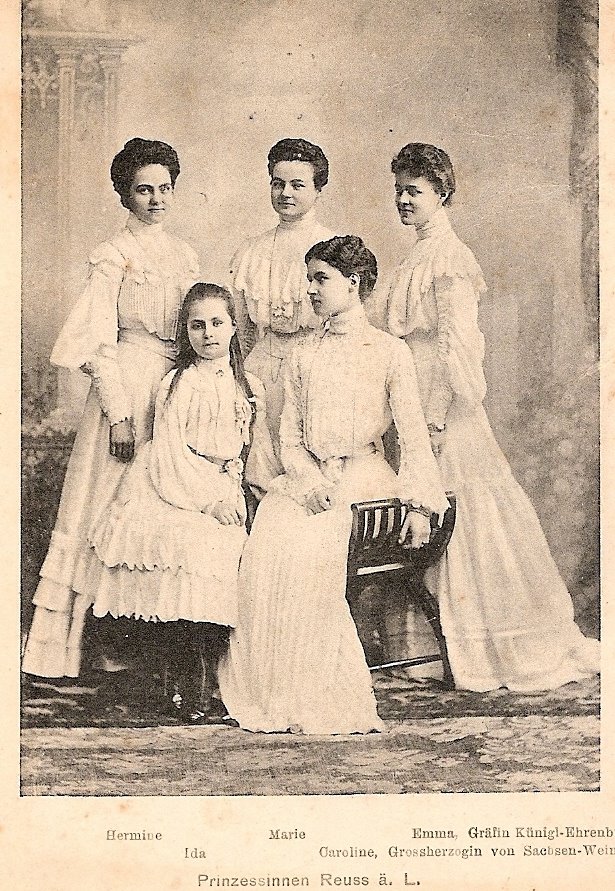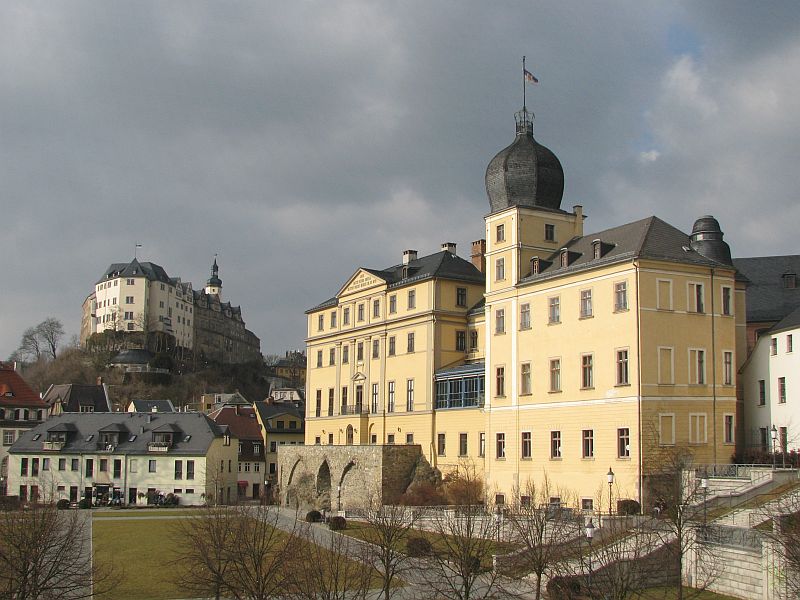by Susan Flantzer © Unofficial Royalty 2020
NOTE: All males of the House of Reuss were named Heinrich plus a number. In the Reuss-Greiz (Older Line), the numbering covered all male children and the numbers increased until 100 was reached and then started again at 1. In the Reuss-Gera (Younger Line), the system was similar but the numbers increased until the end of the century before starting again at 1. This tradition was seen as a way of honoring Holy Roman Emperor Heinrich VI (reigned 1191 – 1197) who had benefitted the family. Therefore, the Roman numerals seen after names are NOT regnal numbers.
Principality of Reuss-Gera: The House of Reuss began their rule circa 1010. Heinrich XLII became Count of Reuss-Schleiz in 1784, and then also became Count of Reuss-Gera in 1802. In 1806, the united county was raised to the Principality of Reuss-Gera or Reuss Younger Line. Between 1824 and 1848, the senior line of Gera gradually combined the territory of the surviving cadet branches (Lobenstein, Köstritz, and Ebersdorf).
On November 11, 1918, Heinrich XXVII abdicated his position as 5th Prince Reuss of Gera and as Regent abdicated for the disabled Heinrich XXIV, 6th Prince Reuss of Greiz. The new government of Reuss-Gera made an agreement with Heinrich XXVII and granted him some castles and land. The territory encompassing the Principality of Reuss-Gera is now located within the German state of Thuringia.
*********************

Heinrich LXII, 2nd Prince Reuss of Gera; Credit – Wikipedia
Heinrich LXII, 2nd Prince Reuss of Gera was the second but the eldest surviving of the five sons and the third of the eight children of Heinrich XLII, 1st Prince Reuss of Gera and Princess Caroline of Hohenlohe-Kirchberg. He was born on May 31, 1785, in Schleiz, County of Reuss-Schleiz, later in the Principality of Reuss-Gera, now in Thuringia, Germany.
Only two of Heinrich LXII’s siblings survived childhood:
- Princess Philippine Reuss of Gera (1781 – 1866), unmarried
- Count Heinrich LVIII Reuss of Schleiz (born and died 1782), died in infancy
- Countess Ferdinande Reuss of Schleiz (1784 – 1785), died in infancy
- Count Heinrich LXV Reuss of Schleiz (1788 – 1790), died in early childhood
- Heinrich LXVII, 3rd Reuss of Gera (1789 – 1867), his successor, married Princess Adelheid Reuss of Ebersdorf, had five sons and three daughters
- Count Heinrich LXVIII Reuss of Schleiz (1791 – 1792), died in infancy
- Count Heinrich LXXI Reuss of Schleiz (1793 – 1794), died in infancy
Heinrich LXII was educated at the Univerity of Erlangen, now in Erlangen and Nuremberg, Bavaria, Germany, and the University of Würzburg, now in Würzburg, Bavaria, Germany. Upon his father’s death in 1818, Heinrich LXII became the 2nd Prince Reuss of Gera. He was an enthusiastic ruler and immediately set out to improve the education system of his principality. Heinrich LXII also did much to beautify Reuss-Gera, especially along the roads leading to Schleiz. In 1837, Schleiz Castle (link in German) was badly damaged in a fire and Heinrich LXII oversaw the renovations. However, in 1945, Schleiz Castle was destroyed by American bombing during World War II. The ruins were removed in 1950, leaving only the two damaged towers.

Schleiz Castle in the background overlooking Schleiz in 1908; Credit – Wikipedia
After the German revolutions of 1848, Heinrich LXXII, Prince Reuss of Lobenstein and Ebersdorf abdicated. Lobenstein and Ebersdorf then were untied with Heinrich LXII’s possessions. The capital moved from Schleiz to Gera. In 1849, the Principality of Reuss-Gera received a constitution, and a legislature was established in 1851.
Heinrich LXII, 2nd Prince Reuss of Gera died on June 19, 1854, aged 69, in Gera, Principality of Reuss-Gera. He was buried at the Bergkirche St. Marien (link in German) now in Schleiz, Thuringia, Germany. Heinrich LXII never married and so he was succeeded by his brother Heinrich LXVII, 3rd Prince Reuss of Gera.
This article is the intellectual property of Unofficial Royalty and is NOT TO BE COPIED, EDITED, OR POSTED IN ANY FORM ON ANOTHER WEBSITE under any circumstances. It is permissible to use a link that directs to Unofficial Royalty.
Reuss-Gera Resources at Unofficial Royalty
- Principality of Reuss-Gera Index
- Profiles: Reuss-Gera Rulers and Consorts
- Royal Burial Sites of the Principality of Reuss-Gera
Works Cited
- De.wikipedia.org. 2020. Heinrich LXII. (Reuß Jüngere Linie). [online] Available at: <https://de.wikipedia.org/wiki/Heinrich_LXII._(Reu%C3%9F_j%C3%BCngere_Linie)> [Accessed 10 March 2020].
- En.wikipedia.org. 2020. Heinrich LXII, Prince Reuss Younger Line. [online] Available at: <https://en.wikipedia.org/wiki/Heinrich_LXII,_Prince_Reuss_Younger_Line> [Accessed 10 March 2020].
- En.wikipedia.org. 2020. Principality Of Reuss-Gera. [online] Available at: <https://en.wikipedia.org/wiki/Principality_of_Reuss-Gera> [Accessed 10 March 2020].
- Uk.wikipedia.org. 2020. Heinrich LXII, 2Nd Prince Reuss Of Gera (Ukrainian Wikipedia). [online] Available at: <https://uk.wikipedia.org/wiki/%D0%93%D0%B5%D0%BD%D1%80%D1%96%D1%85_LXII_(%D0%BA%D0%BD%D1%8F%D0%B7%D1%8C_%D0%A0%D0%BE%D0%B9%D1%81%D1%81-%D2%90%D0%B5%D1%80%D0%B8)> [Accessed 10 March 2020].
























